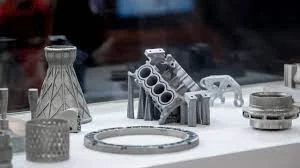Metal 3D printers are helping to revolutionize several industries. Medical professionals use them for prosthetics and implants, aerospace engineers are using them to reduce the weight of aircraft, and industrial manufacturers are using them to create custom tooling equipment.
What is 3D Metal Printing?
3D metal printing is a process that builds up a metal part from the bottom up using layers of metal powder. Depending on the process used, the parts can be very complex and may look nothing like traditional metal fabrications. The resulting prints can be used for prototyping or end-use applications.
The most common materials are aluminum, stainless steel and titanium. Other popular choices include nickel, cobalt and copper alloys. A wide variety of properties are possible for printed metals, including tensile strength, hardness and elongation.
There are several different types of metal 3D printers, ranging from powder bed fusion to material extrusion and binder jetting. Each technology offers its own unique set of advantages and disadvantages, but they all share the ability to print parts with a high level of dimensional accuracy.
While some of these technologies are capable of producing functional, end-use parts, they can also be time consuming and expensive. This is because the metal powders needed are more costly than those typically used in plastic printing.
What are the Advantages of 3D Metal Printing?
As a fabrication technology that promises to enable near net shape parts, 3D printing of metal has generated enormous hype. This blind excitement should not obscure the unique technical advantages of this process, which can significantly improve the performance of metal parts in a few key ways.
Among the most important benefits is cost-effectiveness. By printing in small batches, companies can produce parts more cost-effectively than they could with casting, forcing or sheet metal working, lowering production costs and lead times.
A final benefit is dimensional accuracy. While it is difficult to achieve perfect dimensional accuracy with plastic and composites 3D printing, metal printers offer more accurate results due to their higher layer-thickness. For complex parts, this can make a significant difference in mechanical performance and enables designers to optimize their designs for strength and weight.
Although the current state of 3D metal printing is far from perfect, many companies are working hard to push this technology into production. These efforts include improving dimensional accuracy, surface finish and porosity while also reducing cost. This will require the development of new materials that are both durable and cost-effective, as well as new machines that can use a wide range of metal powders simultaneously to fabricate parts with greater fidelity.
What are the Disadvantages of 3D Metal Printing?
Currently, 3D printing is most popular for prototyping and manufacturing small to medium-volume parts. The technology is also more cost-effective than traditional manufacturing processes and can produce a wide variety of parts quickly and reliably.
However, there are some disadvantages to the process. One of the main disadvantages of 3D metal printing is the high price of metal powder and print materials. This can be a major barrier to adoption, especially for smaller manufacturers who need to purchase kilos of metal powder at a cost in the hundreds of dollars.
In addition, the use of 3D printers can be environmentally friendly compared to other manufacturing processes. 3D printers are energy-efficient and require significantly less material than injection molding or other forms of production. Additionally, they can eliminate the need for secondary processing and reduce the amount of scrap that is created in the manufacturing process.
What are the Future of 3D Metal Printing?
As with any emerging technology, the success of metal 3D printing is largely up to the companies that take advantage of it. The industry has already started to shake up traditional manufacturing processes and reduce the number of steps in a production line. This can be a boon to consumers who want faster, cheaper products but also for manufacturers who are willing to redesign their designs to accommodate the new technology.
For now, the best applications for metal 3D printing are fully functional prototypes, tooling, jigs and fixtures, and small-scale production parts. These can be used for any number of purposes from creating specialized tools for surgeons to designing and printing complex medical implants and prosthetics. Additionally, these tools can be designed to be lighter and more durable than their traditional counterparts, making them an ideal choice for aerospace and automotive industries.
The ability to print multiple parts together has opened up new opportunities for metal additive manufacturing. One company, Netfabb, developed a process called stacking to create complex parts that were previously impossible to make using DMLS. Essentially, a single part was layered onto the next with different materials, including steel and aluminum, while supporting structures were created in between layers to keep the parts together. As a result, the company was able to create a car door handle that weighs less than a traditional one while providing the same strength.


